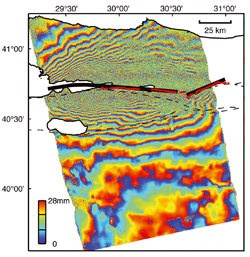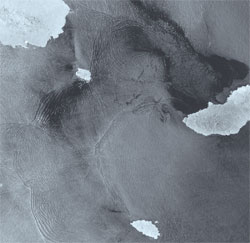Description
These instruments transmit at frequencies of around 1 to 10GHz and measure the backscattered signals to generate microwave images of Earth’s surface at high spatial resolutions (between 10m and 100m) and with a swath width of around 100km. Both synthetic aperture radars (SARs) and some real aperture side-looking imaging radar systems fall into this category. The images produced have a similar resolution to those from high resolution optical imagers, but radars have the capability to ‘see’ through clouds providing data on an all weather, day/night basis.
SARs also have the ability to penetrate vegetation and to sample surface roughness and surface dielectric properties. They may also be used to obtain polarisation information and although the operating wavelength is in general fixed for a given radar, radars operating at a variety of wavelengths (typically L-, C- and X-band) are and will be available during the next decade
The beam shape and direction of new generation SARs enable imagery to be acquired from many points on the Earth more frequently. Multipolarised SARs (such as ASAR on ENVISAT) enable land cover to be classified more accurately and will provide quantitative data on biophysical parameters such as soil moisture and biomass.
A number of bistatic radar system concepts (such as BISSAT) are under study. A bistatic radar is a system that operates with separated transmitting and receiving antennae. Since a number of large active radar missions are foreseen for the coming decade, there is the opportunity to use relatively small satellite missions, with passive payloads, flying in formation with one of these missions in order to gather the backscatter information.
Applications
Although a variety of backscatter measurements may be taken by imaging radars, interpretation of these measurements is a complex and, in some cases, still developing science. However, significant advances in a number of areas and a number of SAR applications are now fully operational.
Backscatter from the ocean can be used to deduce surface waves, to detect and analyse surface features such as fronts, eddies, and oil slicks, and to detect and track ships. Operational wave and sea ice forecasting is also an important near real-time application of SAR data.
Land images may be used to infer information on vegetation type and cover, and are therefore of use in forestry and agriculture – the ability of SARs to penetrate cloud cover makes them particularly valuable in rainforest studies, and also in resource monitoring applications. The information obtained from such images depends upon the characteristics (eg wavelength) of the probing radiation – under certain conditions, for example, some penetration of vegetation may be feasible. Such imagery is often used in order to complement visible/IR multi-spectral imagery by, in effect, providing an additional microwave channel. One of the most important current applications of imaging radars, however, is in all-weather measurements of snow and ice sheets, from which information on topography, texture and motion may be inferred; flood detection is another proven capability of SAR.
A technique known as interferometry is used to record the phase shift between 2 SAR images recorded at slightly different times, thereby providing accurate information on the motion of surfaces and targets and allowing large scale 3-D topographical images to be produced. Similar stereo images may be produced using conventional SAR images taken on adjacent orbits. Differential SAR interferometry is valuable for detection of ground movements at millimetre/sub-millimetre level and of interest in the context of tectonic and volcanic hazard studies, and in studies of subsidence in urban areas.
 An interferogram created using pairs of images taken by the ERS-2 SAR, showing surface deformation or changes that may have occurred during and after the 17 August 1999 Izmit, Turkey earthquake. Each of the colour contours represents 28 mm of motion towards the satellite, or about 70mm of horizontal motion. |
 RADARSAT data was used to assist oil spill clean-up in the Galapagos islands |
| Current & planned instruments AMI/SAR/Image AMI/SAR/wave ASAR ASAR (image mode) ASAR (wave mode) BISSAT L-band SAR L-SAR PALSAR RLSBO SAR (RADARSAT) SAR (RADARSAT-2) SAR (RISAT) SAR (ROSHYDROMET) SAR (SAOCOM) SAR 2000 S-band SAR TerraSAR-X |
ASAR: envisat.esa.int/instruments/asar/index.html |